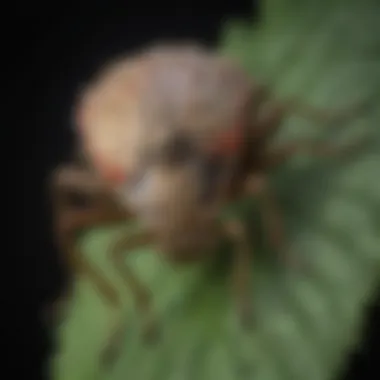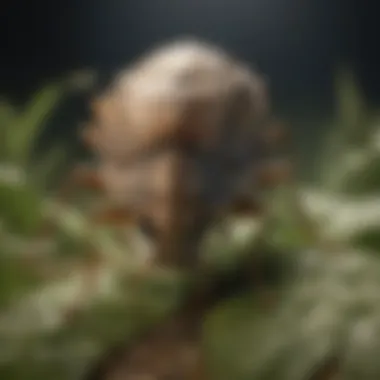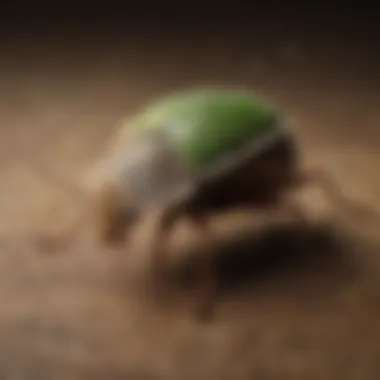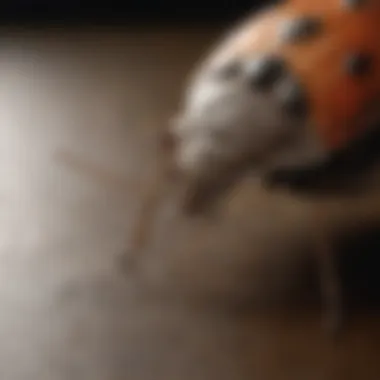Understanding the Threat of Stink Bugs to Humans


Intro
Understanding the threat posed by stink bugs involves a careful examination of their characteristics and behaviors. These insects have gained attention for their potential impact on agriculture and even their nuisance factor in homes. However, it is essential to differentiate between mere inconvenience and genuine danger. This exploration will enable readers, particularly homeowners, to grasp the intricacies of stink bugs and their place in the environment.
Understanding Pests
Definition of Pests
Pests can be defined as organisms that are harmful to crops, livestock, or human health. They can range from insects to rodents, and each type poses different risks. Stink bugs, specifically, fall into the category of agricultural pests. They often invade gardens and fields, causing damage to plants through their feeding habits.
Importance of Pest Identification
Identifying pests accurately is crucial for effective management. Stink bugs can often be confused with other similar-looking insects. By understanding their specific traits, homeowners can take appropriate action before an infestation occurs. Proper identification includes recognizing their shield-like shape, mottled brown or green color, and the distinctive odor they release when disturbed. Being able to identify stink bugs can also inform decisions on control methods, whether through chemical means or natural remedies.
Prevention Techniques
Home and Garden Preventative Measures
Preventing stink bugs from entering homes and gardens requires an integrated approach. Here are several effective strategies:
- Sealing Entry Points: To guard against stink bugs, inspect windows, doors, and vents. Use caulk to fill gaps and ensure screens are in good repair.
- Proper Sanitation: Keep gardens and yards tidy by removing debris that provides shelter to pests. Dispose of any overripe fruit or vegetables, as they can attract stink bugs.
- Lighting Choices: Outdoor lights can attract stink bugs. Use yellow bulbs, which are less likely to draw these insects.
Seasonal Prevention Tips
Stink bugs are more active in certain seasons, primarily during late summer and fall. During this time, homeowners should increase vigilance:
- Monitor Plants: Regularly inspect plants for the presence of stink bugs. Early detection leads to easier control.
- Use Traps: DIY traps can be effective. A simple mixture of soapy water in a bucket can lure and drown stink bugs.
- Professional Inspection: Consider engaging pest control services for a seasonal inspection. They can provide treatments before the pests become a problem.
Eco-Friendly Pest Control Solutions
Overview of Sustainable Practices
Choosing eco-friendly solutions is becoming ever more popular among homeowners. Sustainable practices promote environmental health while effectively managing pest populations. Practices include:
- Companion Planting: Certain plants can deter stink bugs. For example, planting basil next to tomatoes can confuse and repel them.
- Encouraging Natural Predators: Birds and beneficial insects, like parasitic wasps, can help maintain stink bug populations naturally.
Natural Remedies and Their Effectiveness
Natural remedies can also be a viable alternative to chemical pesticides. Some methods include:
- Essential Oils: Oils, such as peppermint or clove oil, may repel stink bugs when diluted with water and sprayed in infested areas.
- Vinegar Solutions: A mixture of vinegar and water sprayed onto plants can help deter stink bugs.
- Diatomaceous Earth: Sprinkling food-grade diatomaceous earth around plants can create an inhospitable environment for these pests.
Understanding stink bugs' biology, behaviors, and control methods can empower homeowners to minimize their impact on their living environments and gardens.
Foreword to Stink Bugs
In order to comprehend the potential dangers associated with stink bugs, it is essential to begin with a foundational understanding of these insects. This section aims to clarify what stink bugs are, their characteristics, and the various species that exist. Understanding stink bugs is crucial not only for discerning their impact on agriculture but also for recognizing any risks they may pose to human health.
Defining Stink Bugs
Stink bugs belong to the family Pentatomidae, which includes over 200 species known for their distinctively unpleasant odor. The name "stink bug" is derived from the scent they emit, especially when threatened. This smell can serve as a defense mechanism against predators. Most stink bugs are characterized by a distinct shield shape and vary in color from green to brown. Common types include the brown marmorated stink bug and the green stink bug, each exhibiting different behaviors and habitat preferences.
Common Species and Their Characteristics


Identifying specific species of stink bugs can help in assessing their impact. Some common species include:
- Brown Marmorated Stink Bug: Originating from Asia, this species is notorious for invading homes. It has a brownish color with white bands on its antennae.
- Green Stink Bug: This bright green bug is often found in gardens. It is recognized for its aggressive feeding habits, targeting various crops.
- Boxelder Stink Bug: Identified by its distinctive orange and black markings, this species feeds primarily on boxelder trees and can sometimes enter homes in the fall.
Understanding these distinctions is vital for effective pest management. Recognizing the particular species present can inform whether they pose any risks to plants or possibly to the indoor environment as well.
Biological Makeup
The biological makeup of stink bugs plays a crucial role in understanding their behaviors and interactions with humans and the ecosystem. By examining their anatomy and life cycles, one can grasp how these insects function and why they exhibit certain behaviors.
Anatomy of a Stink Bug
Stink bugs belong to the family Pentatomidae. One of their distinctive features is their shield-shaped body, which ranges from 10 to 20 mm in length. This shape aids in camouflage amidst foliage. Their exoskeletons are smooth and can be green, brown, or even bright-colored, depending on the species.
Key anatomical features include:
- Mouthparts: Stink bugs possess robust piercing-sucking mouthparts, allowing them to extract plant juices. This feeding method can damage crops, making them significant pests in agriculture.
- Antennae: Two long and segmented antennae are essential for sensing their surroundings, detecting pheromones, and identifying food sources.
- Wings: They have two pairs of wings, with the front pair being thicker and more protective. These wings are a greenish-brown color, aiding in their disguise.
- Chemical glands: Found in their abdomen, these glands produce foul-smelling substances used for defense. This secretion performs a crucial role in deterring predators and signaling to other stink bugs.
Understanding these features helps reveal how stink bugs thrive and reproduce in various environments, causing concern when they invade homes or agricultural areas.
Life Cycle and Reproduction
The life cycle of stink bugs is divided into several stages: eggs, nymphs, and adults. This incomplete metamorphosis is vital for improving their populations rapidly, especially in favorable climates. A female stink bug can lay hundreds of eggs, often clustered on the undersides of leaves.
The stages in their development include:
- Egg Stage: Eggs are usually laid in late spring, often in clusters of 20 to 30. They are a pale-green color and will hatch within a week.
- Nymph Stage: Upon hatching, the nymphs emerge as small, wingless versions of adults. They go through multiple molts, each time maturing in size and developing the features of adult stink bugs. During this phase, they feed voraciously on plants.
- Adult Stage: After several weeks, nymphs become adults. The adults have fully developed wings and reproductive organs, allowing them to mate and continue the cycle. Adult stink bugs can live from a few weeks to several months, depending on environmental conditions.
Stink bugs can have multiple generations in a year, especially in warmer climates, significantly affecting crop yields and pest management strategies.
Grasping their biological makeup is essential for recognizing their potential threats and managing them effectively in both homes and agricultural settings.
Behavioral Patterns
Understanding the behavioral patterns of stink bugs is essential in recognizing their potential impact on human environments and agriculture. These patterns encompass various aspects, from their feeding habits to their defensive behaviors, which together form a comprehensive look at how they interact with their surroundings. By studying these behaviors, homeowners and agricultural stakeholders can develop informed strategies to manage these pests effectively.
Feeding Habits
Stink bugs are primarily suction feeders. They use their piercing mouthparts to extract juices from plants. This feeding method can cause significant damage to crops, such as tomatoes, corn, and apples. When they feed, stink bugs inject saliva that breaks down the plant tissue, allowing them to consume it more easily. This process not only harms the plant but can also lead to secondary infections, making them more vulnerable to disease.
Stink bugs are known to target various plants, which can cause selective pressure on certain crops. As a result, it's necessary for farmers to be aware of their feeding habits and take preventive measures. The presence of stink bugs in a garden or farm can also indicate issues with plant health or ecosystem balance. Monitoring these pests can lead to more effective management solutions.
"A proactive approach to monitoring and understanding stink bug feeding habits can safeguard crops and improve overall plant health."
Defense Mechanisms
Stink bugs have unique defense mechanisms that play a crucial role in their survival. Their name originates from the strong odor they emit when threatened. This chemical defense serves as a deterrent against predators. The scent can be particularly unpleasant, dissuading birds and other potential threats from consuming them.
Moreover, stink bugs have developed behaviors that enhance their ability to evade danger. For example, they can blend in with their surroundings thanks to their dull, earthy coloration. This camouflage makes them less visible to predators. When physically threatened, they tend to remain still, further avoiding detection.
Understanding these behaviors helps in crafting pest management strategies. Homeowners may recognize when stink bugs are present, allowing for timely interventions before they become a serious problem. Identifying threat responses in stink bugs provides important insights into their ecology and interaction with the environment.
Stink Bugs and Human Interaction


The interaction between stink bugs and humans raises important questions about safety and public health. Understanding this relationship helps to demystify the potential threats they pose. Not only do stink bugs affect household environments, but they also have implications in agriculture, which is crucial for food security. This section aims to explore specific risks that stink bugs present to humans, addressing health concerns and agricultural impacts.
Potential Risks to Humans
Stink bugs do not bite humans or transmit diseases. However, certain potential risks exist that warrant attention.
Allergic Reactions
Allergic reactions to stink bugs can occur in some people. These reactions are often linked to the insect's odor. When stink bugs are crushed or disturbed, they release a pungent fluid that can trigger allergic responses in sensitive individuals. Symptoms may include skin rashes, allergies or even sinus issues.
Key characteristics of allergic reactions related to stink bugs include their rarity but severity for those affected. This is an essential consideration for sensitized individuals.
The unique feature is the odoriferous secretion that acts as an irritant. The advantage of understanding this risk is that individuals can take precautionary measures, such as wearing gloves when handling infestations. This education encourages proactive behaviors that help to minimize unpleasant experiences.
Contamination of Indoor Spaces
Stink bugs also contribute to contamination within homes. When they invade indoor spaces, they can leave behind residues that can compromise sanitation. Their waste and odor can lead to unpleasant living conditions.
A vital aspect of this contamination is the odor that can persist long after the bugs are removed. This makes dealing with infestations more challenging for homeowners.
The unique feature is their tendency to swarm, especially in fall, leading to increased contamination. The advantage of recognizing this risk is heightening awareness of proper sanitation practices, thus helping minimize unwanted interactions between humans and stink bugs.
Impact on Agriculture
Stink bugs are significant pests in agricultural settings, often leading to multiple issues for farmers. Their feeding can severely impact crop health, resulting in reduced yields. Therefore, understanding the specific crops affected helps to identify solutions for management.
Crops Affected by Stink Bugs
Stink bugs primarily affect vegetables and fruits, including tomatoes, cucumbers, and apples. Feeding on these plants can result in physical damage and indirect harm through disease transmission.
A key characteristic of their feeding is the use of a needle-like mouthpart that penetrates plant tissues. This is crucial to understanding their method of damage, which can lead to substantial economic losses in agriculture.
The unique feature regarding the crops affected is the wide range of plant species they can infest. This broad impact means many farmers must consider stink bug management as a crucial part of their agricultural strategy to protect their operations.
Economic Consequences for Farmers
The economic consequences of stink bug infestations are severe. Farmers face reduced crop quality, thus hurting marketability and revenue. Estimates show significant financial loss due to decreased yields in affected crops.
The primary characteristic of the economic impact is variability. While some regions face higher levels of infestation, others may not experience similar issues. This variability can create obstacles for farmers in planning and budgeting.
The unique aspect of economic consequences is how it extends beyond the immediate area. Stink bug invasions can affect local economies, prompting changes in job stability and community resources. Recognizing these economic impacts allows for better planning and adaptation in agricultural practices.
Identifying Stink Bugs
Identifying stink bugs plays a critical role in managing their presence in homes and gardens. Clear identification is essential for distinguishing them from other insects that might seem similar, thus enabling effective management and prevention strategies. Recognizing the specific physical features that characterize these insects can help homeowners take appropriate measures when they become a nuisance. Misidentifying stink bugs can lead to unnecessary panic or inappropriate treatment methods, which may not target the correct pest. This section will provide practical insights into how one can accurately identify stink bugs and differentiate them from common look-alikes.
Physical Identification Features
Stink bugs possess several distinctive physical traits that aid in their identification. Here are some key features to look out for:
- Shape: Stink bugs are typically shield-shaped. This unique body shape is a primary identifier.
- Color: Most species exhibit a green or brown coloration, but they can also appear in more striking hues like burgundy.
- Size: Adults range from 0.5 to 1 inch in length, making them relatively easy to spot.
- Antennae: Their antennae are long and segmented, usually with a distinct curve at the end.
- Wings: When at rest, the wings fold flat over their bodies, displaying a vein structure that can be noted as a key detail during identification.
By focusing on these features, homeowners can more confidently identify stink bugs in their surroundings. This knowledge is also useful in discussing pest control options with professionals.


Common Misidentifications
Accurate identification is imperative, as many insects can be confused with stink bugs. Here are some common misidentifications:
- Boxelder Bugs: These insects are also shield-shaped and can be mistaken for stink bugs. However, their color ranges from black to red, lacking the green or brown tones of stink bugs.
- Leaf-footed Bugs: These bugs share a similar shape but are elongated and have flattened hind legs. Their color can also vary, making them different from the true stink bug.
- Other True Bugs: This term encompasses many insects sharing similar physical characteristics. Distinguishing the true stink bug from others can be challenging without recognizing the distinct features mentioned earlier.
It is crucial to accurately identify stink bugs to avoid unnecessary chemical applications, which could impact beneficial insects and the environment negatively.
Ecological Roles
Understanding the ecological roles of stink bugs offers valuable perspective on their presence in both natural and cultivated environments. While many view these creatures primarily as pests, their contributions to ecosystems and agriculture can be significant. Addressing their ecological roles helps clarify their impact and informs pest management strategies that are environmentally conscious.
Stink Bugs in Ecosystems
Stink bugs are integral parts of various ecosystems. They serve as both herbivores and prey within food chains. As herbivores, they predominantly feed on plant sap, which allows them to influence plant growth and health. Particularly, stink bugs feed on the crops and plants they infest. This feeding can lead to stunted growth and decreased yields if their populations are not managed properly.
Moreover, stink bugs do not operate in isolation. They are part of intricate food webs. Many birds and insectivores rely on them as a food source. This predation balances populations of stink bugs and contributes to natural pest control. Stink bugs can also facilitate nutrient cycling by decomposing organic matter, thus supporting soil health. The presence of stink bugs is often an indication of plant community dynamics, showcasing both their role in ecology and their impact on agriculture.
The Balance of Nature
The concept of balance in nature is crucial when discussing the role of stink bugs. While they may damage crops, they also contribute positively to the ecosystem. For instance, certain stink bug species are natural predators of pest insects. This predatorial behavior helps manage populations of agricultural pests without the need for chemical interventions. This scenario illustrates a form of biological control that is increasingly valued by sustainable farming.
Additionally, the reproductive strategies of stink bugs can affect their abundance and impact. They tend to reproduce rapidly, which can lead to population explosions in suitable conditions. Such surges require monitoring to prevent significant damage to crops.
In summary, stink bugs play complex and multifaceted roles within ecosystems. Recognizing their contributions helps foster a more nuanced understanding of these insects and their implications for both human agriculture and natural environments. A balanced view of stink bugs—acknowledging both their roles as pests and as participants in ecological processes—can lead to more effective management strategies.
"The presence of stink bugs in varied environments can indicate shifts in ecological balance, calling for careful observation and understanding."
By examining stink bugs through the lens of their ecological roles, homeowners and farmers can make better-informed decisions about pest control and conservation strategies.
Pest Management Strategies
Pest management strategies are essential for ruling out the presence and impacts of stink bugs in human environments. Understanding the behaviors and habits of these insects allows homeowners and agriculturalists to employ effective measures to mitigate potential problems. The focus here is on prevention, control methods, and the balance of chemical versus natural solutions. The importance lies not only in safeguarding crops but also in maintaining a comfortable living space for residents.
Preventive Measures
Preventive measures are the first line of defense against stink bugs. These strategies aim to keep these pests at bay before they even enter your home or fields. Key preventive methods include:
- Sealing Entry Points: It is crucial to inspect the exterior of homes for cracks and gaps. Seal windows, doors, and even areas around vents with caulk or weather stripping. This action drastically reduces the access points available to stink bugs.
- Proper Landscaping Practices: Keeping plantings away from the foundation of the house can be beneficial. Stink bugs are attracted to vegetation and limiting their access is prudent. Opting for mulch instead of rocks can help in reducing insect visibility as well.
- Regular Cleaning: Maintaining cleanliness both indoors and outdoors aids in limiting attraction. Remove any debris or fallen fruits from yards, as these attract stink bugs.
Chemical and Natural Control Methods
Both chemical and natural control methods exist to manage stink bug populations effectively. Each has its own set of benefits and drawbacks, which should be weighed carefully.
- Chemical Control: Pesticide use can be effective but comes with potential downsides. Homeowners often turn to products like Talstar, which specifically targets stink bugs. While they can significantly reduce numbers, caution should be applied. Chemical methods should ideally be used with care, ensuring that non-target insects and pets are not harmed. Always follow the instructions on product labels for safety and efficiency.
- Natural Control: On the other hand, natural methods are gaining traction among eco-conscious homeowners. This includes inviting natural predators like birds and spiders, which prey on stink bugs. Another method involves using diatomaceous earth, a natural powder that damages the exoskeleton of insects, leading to their demise.
It is essential to assess environmental impact while implementing pest control methods. The choice between chemical and natural solutions often depends on individual circumstances and personal values.
"A successful pest management strategy balances efficacy and safety, allowing both humans and the environment to thrive.”
Culmination
Understanding the risks and importance of stink bugs is not just about identifying these insects; it extends to grasping their implications for human health and agriculture. This article has explored various aspects of stink bugs, from their biological makeup to the significant threats they may pose.
Summarizing the Risks and Importance
Stink bugs might seem innocuous at first glance, yet their presence can lead to various issues. They can affect crops, leading to economic losses for farmers, and result in allergic reactions or indoor contamination for homeowners.
- Health Concerns: Many may experience reactions like sneezing or skin irritations from coming into contact with these pests. While not directly harmful, their scent can cause discomfort.
- Agricultural Impact: Stink bugs are notorious for damaging crops, particularly fruits and vegetables. Their feeding habits can lead to significant financial losses in agriculture.
- Environment Interaction: Stink bugs play a role in the ecosystem, but their rapid reproduction and mobility can disrupt local biodiversity.
Thus, understanding their behavior, risks, and management strategies becomes vital for those who have gardens or live in areas prone to infestations. Educating oneself about preventive measures is essential, enabling homeowners to mitigate potential threats effectively.



